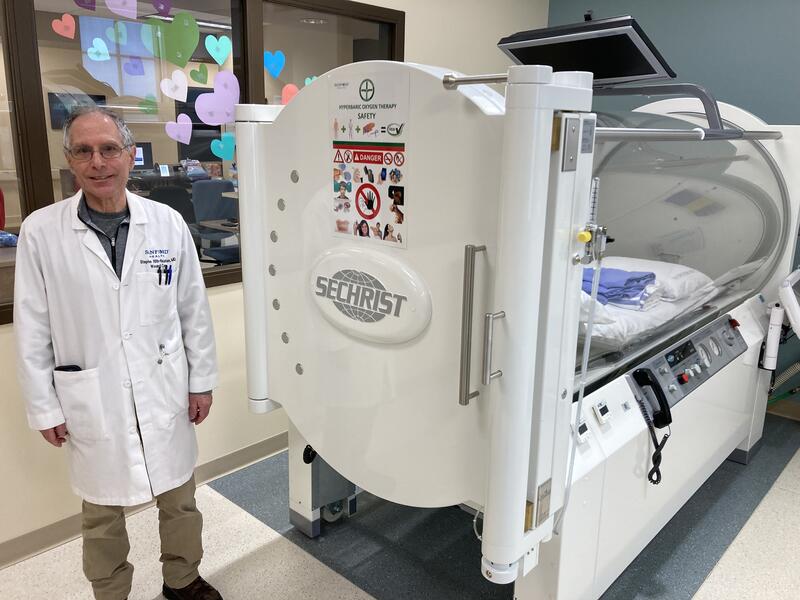After nearly 40 years working in wound care and 10 years in hyperbaric medicine, Stephen Rith-Najarian, M.D., knows a thing or two about the benefits and dangers of hyperbaric chambers.
The Sanford Bemidji doctor is an outspoken advocate for providing thoughtful, appropriate care to patients seeking treatment, even if that means turning them away.
“Most importantly is patient selection,” Dr. Rith-Najarian said. “Making sure that we’re treating people for whom there’s solid scientific evidence, that there’s benefit, and that benefit outweighs the risk of potential complications.”
Treating the right conditions
This strict adherence to appropriate care has always been a tenet of Dr. Rith-Najarian and Sanford Health. But it became even more notable after news broke of a tragedy at a boutique hyperbaric facility in Michigan.
A 5-year-old boy died when a spark inside his hyperbaric chamber ignited a fire. That facility’s website claims to treat over 100 conditions, including many which are not recognized by the Food and Drug Administration as treatable with hyperbaric oxygen therapy. These include autism, ADHD, dyslexia, sleep apnea and many more.
“People with these conditions are looking for answers. They’re looking for treatment. And there are boutique programs that will offer hyperbaric medicine for these conditions when there just isn’t the solid evidence for it, or even no evidence,” Dr. Rith-Najarian said.
Sanford Health uses hyperbaric medicine to treat conditions with verifiable benefits for patients, such as oral wounds and tissue inflammation which may occur following radiation treatment. Other conditions such as bone infections, skin flaps and diabetic foot wounds are also treated by Dr. Rith-Najarian.
Safety first
Fire safety is a top priority with hyperbaric oxygen treatment. At the wound care clinic in Bemidji, a rigorous checklist is followed for each treatment. This includes grounding each patient to prevent the build-up of static electricity. Grounding bracelets are worn by patients in the chamber, and they allow any potential static charge to flow to the ground outside of the chamber.
“If you think about how much oxygen we have right now, it’s 21% of the air we breathe. In a chamber, it’s 100%, so that’s five times,” Dr. Rith-Najarian said. “It’s very, very concentrated oxygen. And at those levels, if you have a spark and anything that is combustible, it will ignite instantaneously. So what we do to prevent that is the grounding. We also have a very strict protocol for checking for anything that might be flammable, and it is removed before it goes in the chamber.”
On top of that, the team rarely provides treatment to children.
“One thing that we take into consideration is a person’s ability to follow directions,” said Dr. Rith-Najarian. “If you have a child, it’s hard to regulate that behavior all the time. Those are the kinds of things that we put on our no-fly list. If we had somebody who had severe cognitive impairment with dementia, we would consider that a reason not to offer the treatment, because of that risk of inadvertently fidgeting and pulling off your ground.”
Most of all, Dr. Rith-Najarian stresses the importance of seeking treatment at a medical center rather than a boutique facility because of the safety protocols and guidelines that are in place.
“We have a joint commission. We have our own internal reviews. We have all those guardrails that make sure that we’re providing the best quality care for getting good outcomes and doing it safely,” Dr. Rith-Najarian said. “In a boutique center, they may or may not have that. We just don’t know.”
Learn more
- Hyperbaric oxygen therapy: A unique service in Bemidji
- Cuts, scrapes, burns – when first aid isn’t enough
- The importance of dental care after head or neck radiation
…
Posted In Bemidji, Family Medicine, Orthopedics, Rehabilitation & Therapy, Sports Medicine
